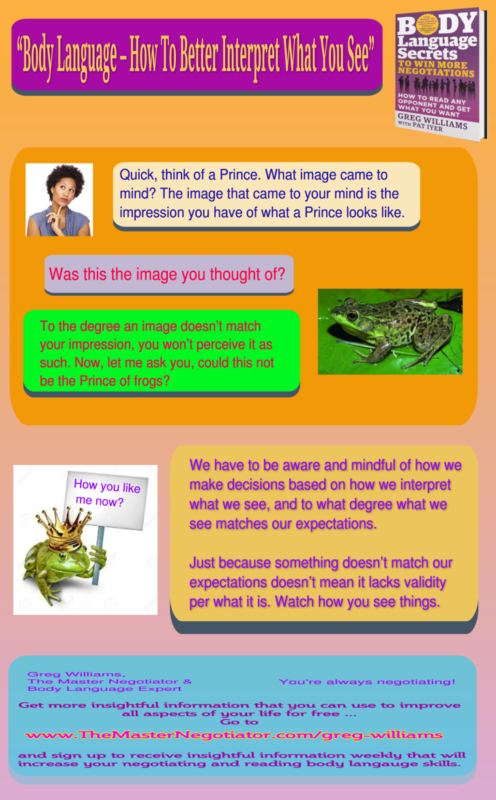Body Language – How to Better Interpret What You See
Body Language – How to Better Interpret What You See https://csuiteold.c-suitenetwork.com/advisors/wp-content/themes/csadvisore/images/empty/thumbnail.jpg 150 150 Greg Williams, MN, CSP https://secure.gravatar.com/avatar/1f08a50bcaed92eae0990a65c7808a62?s=96&d=mm&r=g
“Sometimes, the subliminal mind stores impressions of what the conscious mind is unaware of. In order to see better, look for the unseen.” –Greg Williams, The Master Negotiator & Body Language Expert,www.TheMasterNegotiator.com
When observing your body language, do you take the time to interpret what you see? I don’t mean, if you see a cat, you recognize it as a cat and then go about addressing your next activity. What I’m referring to, especially when it comes to major decisions, is understanding how you formulate your decision based on the way you interpret what you’re seeing.
When it comes to reading body language, many experts will inform you that the eyes are the window to the soul. That’s true to a degree and not so truthful. The one consideration that has to be factored in that analysis is the interpreter. That means, per the way each of us see ourself, we see the world. Thus, if we say someone looks up and to the left, they’re recalling something that’s occurred in the past, we may be right. We could also be wrong if that person’s inclination is to look up and to the left when considering future activities. Therefore, we must know how that person uses her eyes to gain a higher level of perspective per what that person is doing at that time. That’s one aspect per how we perceive that person. The other aspect that we should consider is why we’re giving the meaning to that person’s actions (i.e. what we really saw). If you’ve observed the person’s eye movement throughout a conversation and you note that she looks up and to the left when considering future activities, you have a foundation upon which to base your assumptions. Ergo, be sure to base your perception and what you see on a firm foundation, not just conjecture. To do so otherwise could cause you to fall prey to your lying eyes attempting to convince you that you’re seeing the truth. Your eyes may not lie to you, but they can be lied to, which could place you in a quagmire.
Consider the following checklist, based on the importance of the decision.
- Ask why you’re interpreting what you see the way you’re interpreting it.
- Ask yourself what you’re not seeing or taking into account per what you’re seeing.
- Consider how you might alter your perspective by looking at the situation differently.
- Ask, if I continue to see something from the same perspective, where might it lead my thoughts.
- How long do I need to think about this? Should I take a break, and if so for how long before I can revisit and possibly reframe what I’m seeing.
It’s been said that seeing is believing. That’s true to some degree because to a degree we see what we expect to see; that has to do with the way our brain perceives motion, fills in voids, etc. The point is, while we believe our eyes don’t lie to us, we can believe a lie that we see. Thus, always be mindful about how you glean some clues as to what someone is thinking, based on the movement of their eyes. Eye movement is part of the puzzle. To be more exact, look for clusters of body movements (i.e. hands, head, feet, etc.) to add validity to your assessment.
The better you become at deciphering how you interpreted what your eyes see, the better you’ll be able to read body language. Then, you’ll be more certain about believing what your eyes are telling you … and everything will be right with the world.
Remember, you’re always negotiating!

